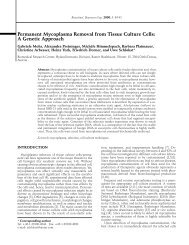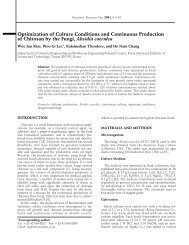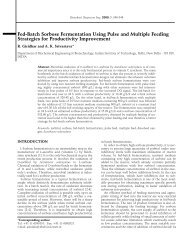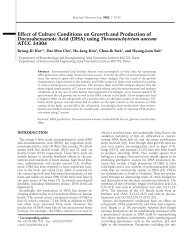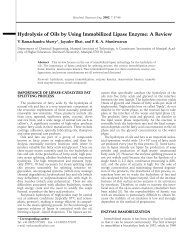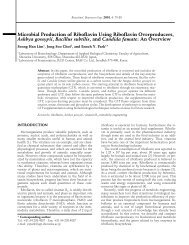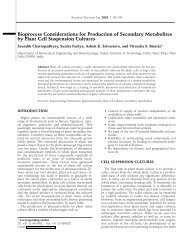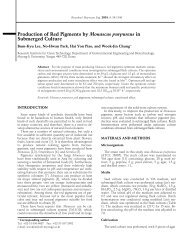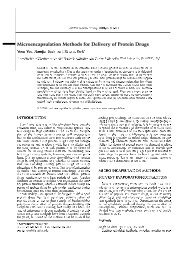Microencapsulation Methods for Delivery of Protein Drugs
Microencapsulation Methods for Delivery of Protein Drugs
Microencapsulation Methods for Delivery of Protein Drugs
Create successful ePaper yourself
Turn your PDF publications into a flip-book with our unique Google optimized e-Paper software.
Biotechnol. Bioprocess Eng. 2001, Vol. 6, No. 4 221<br />
Raw<br />
materials<br />
8. Schematic diagram <strong>of</strong> a spray dryer used <strong>for</strong> prepara-<br />
Fig.<br />
<strong>of</strong> PLGA microparticles containing TRH. From reference<br />
tion<br />
[48].<br />
obtained, from which zero order release <strong>of</strong> TRH<br />
were<br />
<strong>for</strong> one month with a minimal initial burst.<br />
continued<br />
4 lists some examples <strong>of</strong> microspheres prepared by<br />
Table<br />
drying.<br />
spray<br />
Advantages<br />
<strong>of</strong> the major advantages <strong>of</strong> spray drying is its<br />
One<br />
applicability. Both hydrophilic and hydrophobic<br />
general<br />
can be used with proper selection <strong>of</strong> the sol-<br />
polymer<br />
[52]. Spray drying is useful <strong>for</strong> encapsulating even<br />
vent<br />
drugs, such as proteins or peptides, be-<br />
heat-sensitive<br />
it involves mild temperatures [52]. Although<br />
cause<br />
drying includes hot air stream, the temperature <strong>of</strong><br />
spray<br />
droplets may be maintained below the drying air<br />
the<br />
due to rapid evaporation <strong>of</strong> the solvent.<br />
temperature<br />
effective temperature applied to the drug itself is<br />
The<br />
enough to be used <strong>for</strong> proteins. Moreover, spray<br />
mild<br />
is time effective. Spray drying can yield results<br />
drying<br />
to those <strong>of</strong> conventional methods in terms<br />
equivalent<br />
size distribution, particle morphology, and release<br />
<strong>of</strong><br />
yet with the advantage <strong>of</strong> high encapsulation<br />
kinetics,<br />
and the short duration <strong>of</strong> the preparation<br />
efficiency<br />
[53]. The spray drying equipment is easily<br />
procedure<br />
at the manufacturing site. Also, as a one-stage<br />
available<br />
process, spray drying is ideal <strong>for</strong> production <strong>of</strong><br />
closed<br />
materials and good manufacturing practice<br />
sterile<br />
(GMP) [30].<br />
Limitations<br />
TRH-PLGA<br />
solution<br />
Air filter<br />
Pump<br />
air<br />
Double<br />
nozzle<br />
Heater<br />
Drying<br />
chamber<br />
Mannitol<br />
solution<br />
Spray<br />
nozzle<br />
Blower<br />
Cyclone<br />
Receiver<br />
During spray drying, considerable amounts <strong>of</strong> the<br />
4. Examples <strong>of</strong> microencapsulation <strong>of</strong> proteins by spray<br />
Table<br />
drying<br />
Polymer Solvent <strong>Protein</strong> Particle<br />
size<br />
β-glucuronidase<br />
Bovine<br />
somatotropin<br />
Human<br />
erythropoietin<br />
Albumin/<br />
with<br />
Acacia<br />
as PVP<br />
coacervate<br />
stabilizer<br />
anhy- Poly<br />
dride<br />
PLGA<br />
Distilled<br />
water<br />
5 µm<br />
Dichloro-<br />
1-5 µm<br />
methane <br />
Dichloro-<br />
10 µm<br />
methane<br />
Release kinetics Ref.<br />
initial burst<br />
Biphasic:<br />
within 6h followed<br />
(31%)<br />
zero order release <strong>for</strong> 2<br />
by<br />
weeks<br />
release <strong>for</strong> 6 h due to<br />
90%<br />
fast degradation <strong>of</strong><br />
the<br />
and small parti-<br />
polymer<br />
size cle<br />
burst during 24 h<br />
Initial<br />
no further release <strong>for</strong><br />
and<br />
months, likely due to<br />
2<br />
interac-<br />
protein-polymer<br />
and insoluble protein<br />
tion<br />
aggregates<br />
can be lost during the process due to sticking<br />
material<br />
the microparticles to the wall <strong>of</strong> the drying chamber.<br />
<strong>of</strong><br />
drying process can <strong>of</strong>ten lead to change <strong>of</strong> poly-<br />
Spray<br />
<strong>of</strong> the spray dried drugs [66,67]. For exammorphism<br />
progesterone crystal in its original alpha <strong>for</strong>m (m.p.<br />
ples,<br />
turned into beta <strong>for</strong>m (m.p. 395K) when it was<br />
402K)<br />
dried in combination with PLA. Fiber <strong>for</strong>mation<br />
spray<br />
be another major problem in spray drying PLA [67].<br />
can<br />
are <strong>for</strong>med due to insufficient <strong>for</strong>ces present to<br />
Fibers<br />
up the liquid filament into droplets. It depends on<br />
break<br />
the type <strong>of</strong> polymer and, to a lesser extent, the<br />
both<br />
<strong>of</strong> the spray solution. For example, ethyl cellu-<br />
viscosity<br />
solutions made spherical droplets at relatively high<br />
lose<br />
however PLA solutions <strong>of</strong> considerably<br />
concentrations,<br />
concentration and viscosity resulted in fibers.<br />
low<br />
are a number <strong>of</strong> process variables that should be<br />
There<br />
<strong>for</strong> drug encapsulation. They include feed<br />
optimized<br />
properties, such as viscosity, uni<strong>for</strong>mity, and<br />
material<br />
<strong>of</strong> drug and polymer mixtures, feed rate,<br />
concentration<br />
<strong>of</strong> atomization, and the inlet and outlet tem-<br />
method<br />
[32]. The dependence on so many variables<br />
peratures<br />
become a problem in terms <strong>of</strong> reproducibility and a<br />
may<br />
process. In addition, the amount <strong>of</strong> polymer<br />
scale-up<br />
drugs <strong>for</strong> encapsulation may be limited, since<br />
and/or<br />
fluid <strong>of</strong> high viscosity cannot be sprayed.<br />
GELATION /<br />
IONOTROPIC<br />
COMPLEXATION<br />
POLYELECTROLYTE<br />
gelation (IG) is based on the ability <strong>of</strong><br />
Ionotropic<br />
to crosslink in the presence <strong>of</strong> counter<br />
polyelectrolytes<br />
to <strong>for</strong>m hydrogels. Since the use <strong>of</strong> alginate <strong>for</strong> cell<br />
ions<br />
[68], ionotropic gelation has been widely<br />
encapsulation<br />
used <strong>for</strong> both cell and drug encapsulation.<br />
Method<br />
is one <strong>of</strong> the most widely used polyanion <strong>for</strong><br />
Alginate<br />
Alginate is composed <strong>of</strong> 1,4-linked<br />
microencapsulation.<br />
beta-D-mannuronic acid and alpha-D-guluronic acid<br />
[60]<br />
[56]<br />
[62]





